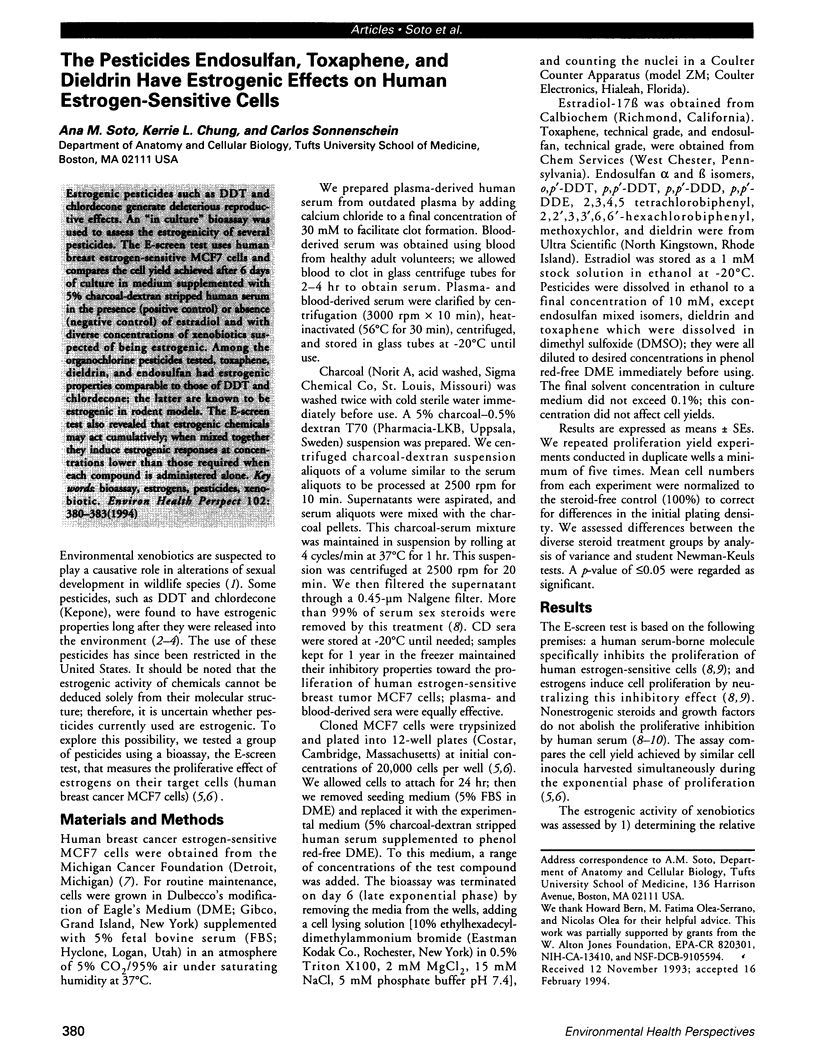Abstract
Estrogenic pesticides such as DDT and chlordecone generate deleterious reproductive effects. An "in culture" bioassay was used to assess the estrogenicity of several pesticides. The E-screen test uses human breast estrogen-sensitive MCF7 cells and compares the cell yield achieved after 6 days of culture in medium supplemented with 5% charcoal-dextran stripped human serum in the presence (positive control) or absence (negative control) of estradiol and with diverse concentrations of xenobiotics suspected of being estrogenic. Among the organochlorine pesticides tested, toxaphene, dieldrin, and endosulfan had estrogenic properties comparable to those of DDT and chlordecone; the latter are known to be estrogenic in rodent models. The E-screen test also revealed that estrogenic chemicals may act cumulatively; when mixed together they induce estrogenic responses at concentrations lower than those required when each compound is administered alone.
Full text
PDF



Images in this article
Selected References
These references are in PubMed. This may not be the complete list of references from this article.
- Colborn T., vom Saal F. S., Soto A. M. Developmental effects of endocrine-disrupting chemicals in wildlife and humans. Environ Health Perspect. 1993 Oct;101(5):378–384. doi: 10.1289/ehp.93101378. [DOI] [PMC free article] [PubMed] [Google Scholar]
- Giwercman A., Carlsen E., Keiding N., Skakkebaek N. E. Evidence for increasing incidence of abnormalities of the human testis: a review. Environ Health Perspect. 1993 Jul;101 (Suppl 2):65–71. doi: 10.1289/ehp.93101s265. [DOI] [PMC free article] [PubMed] [Google Scholar]
- Gupta P. K., Gupta R. C. Pharmacology, toxicology and degradation of endosulfan A review. Toxicology. 1979 Jun-Jul;13(2):115–130. [PubMed] [Google Scholar]
- Guzelian P. S. Comparative toxicology of chlordecone (Kepone) in humans and experimental animals. Annu Rev Pharmacol Toxicol. 1982;22:89–113. doi: 10.1146/annurev.pa.22.040182.000513. [DOI] [PubMed] [Google Scholar]
- Hammond B., Katzenellenbogen B. S., Krauthammer N., McConnell J. Estrogenic activity of the insecticide chlordecone (Kepone) and interaction with uterine estrogen receptors. Proc Natl Acad Sci U S A. 1979 Dec;76(12):6641–6645. doi: 10.1073/pnas.76.12.6641. [DOI] [PMC free article] [PubMed] [Google Scholar]
- Herbst A. L., Anderson D. Clear cell adenocarcinoma of the vagina and cervix secondary to intrauterine exposure to diethylstilbestrol. Semin Surg Oncol. 1990;6(6):343–346. doi: 10.1002/ssu.2980060609. [DOI] [PubMed] [Google Scholar]
- Kupfer D. Effects of pesticides and related compounds on steroid metabolism and function. CRC Crit Rev Toxicol. 1975 Oct;4(1):83–124. doi: 10.1080/10408447509163835. [DOI] [PubMed] [Google Scholar]
- Palmiter R. D., Mulvihill E. R. Estrogenic activity of the insecticide kepone on the chicken oviduct. Science. 1978 Jul 28;201(4353):356–358. doi: 10.1126/science.78523. [DOI] [PubMed] [Google Scholar]
- Sharp G. B., Cole P., Anderson D., Herbst A. L. Clear cell adenocarcinoma of the lower genital tract. Correlation of mother's recall of diethylstilbestrol history with obstetrical records. Cancer. 1990 Nov 15;66(10):2215–2220. doi: 10.1002/1097-0142(19901115)66:10<2215::aid-cncr2820661029>3.0.co;2-q. [DOI] [PubMed] [Google Scholar]
- Sharpe R. M., Skakkebaek N. E. Are oestrogens involved in falling sperm counts and disorders of the male reproductive tract? Lancet. 1993 May 29;341(8857):1392–1395. doi: 10.1016/0140-6736(93)90953-e. [DOI] [PubMed] [Google Scholar]
- Singh S. K., Pandey R. S. Effect of sub-chronic endosulfan exposures on plasma gonadotrophins, testosterone, testicular testosterone and enzymes of androgen biosynthesis in rat. Indian J Exp Biol. 1990 Oct;28(10):953–956. [PubMed] [Google Scholar]
- Soto A. M., Justicia H., Wray J. W., Sonnenschein C. p-Nonyl-phenol: an estrogenic xenobiotic released from "modified" polystyrene. Environ Health Perspect. 1991 May;92:167–173. doi: 10.1289/ehp.9192167. [DOI] [PMC free article] [PubMed] [Google Scholar]
- Soto A. M., Silvia R. M., Sonnenschein C. A plasma-borne specific inhibitor of the proliferation of human estrogen-sensitive breast tumor cells (estrocolyone-I). J Steroid Biochem Mol Biol. 1992 Dec;43(7):703–712. doi: 10.1016/0960-0760(92)90296-u. [DOI] [PubMed] [Google Scholar]
- Soto A. M., Sonnenschein C. Mechanism of estrogen action on cellular proliferation: evidence for indirect and negative control on cloned breast tumor cells. Biochem Biophys Res Commun. 1984 Aug 16;122(3):1097–1103. doi: 10.1016/0006-291x(84)91204-x. [DOI] [PubMed] [Google Scholar]
- Soule H. D., Vazguez J., Long A., Albert S., Brennan M. A human cell line from a pleural effusion derived from a breast carcinoma. J Natl Cancer Inst. 1973 Nov;51(5):1409–1416. doi: 10.1093/jnci/51.5.1409. [DOI] [PubMed] [Google Scholar]
- Wolff M. S., Toniolo P. G., Lee E. W., Rivera M., Dubin N. Blood levels of organochlorine residues and risk of breast cancer. J Natl Cancer Inst. 1993 Apr 21;85(8):648–652. doi: 10.1093/jnci/85.8.648. [DOI] [PubMed] [Google Scholar]





